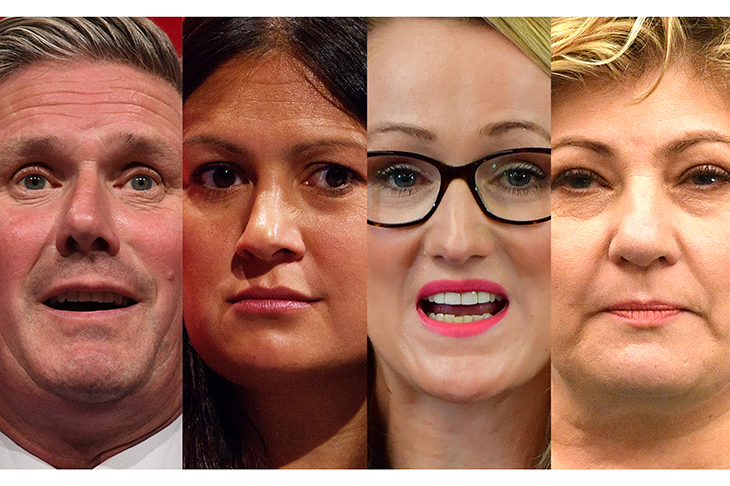In the past 40 years in Britain, only two leaders of the opposition have gone on to become prime minister: Tony Blair and David Cameron. Both were elected on a platform of ‘change to win’ by parties keen enough for power to do just that. Looking at the current Labour leadership contest, it is painfully clear how far the party is from that position.
The one candidate prepared to break decisively with the past four years has already dropped out. Jess Phillips has left the race because she can’t get the nominations from either constituency Labour parties or trade unions and other affiliated groups to make it on to the final ballot, which goes before party members next month. The lack of an audience for Phillips’s message is a reminder that the party has not yet come to terms with the scale of its rejection by the electorate last month. A poll of Labour members this week showed that they still view Jeremy Corbyn more favorably than any other Labour leader of the past 100 years.
Rebecca Long-Bailey, the shadow business secretary, is the candidate keenest to associate herself with the Corbyn project. When asked in a recent interview to give his leadership marks out of 10, she gave him 10. But the other candidates, while not being quite so obviously fawning, are still not prepared to tell the membership hard truths. They accept the fundamental premises of the manifesto rather than regarding it as a disaster. Keir Starmer, the shadow Brexit secretary, says it was ‘overloaded’ — which implies that what it was trying to carry was good. Lisa Nandy believes the failure was one of prioritization rather than of principle. She also excuses Corbyn’s failure by saying he was ‘trashed’ by certain sections of the media. Emily Thornberry, the shadow foreign secretary (and the candidate who should be able to be a truth-teller given how unlikely she is to win), says it ‘was too broad, too ambitious’ which, again, suggests that the ambition wasn’t wrong, just too great.
All the candidates talk more of reuniting the Labour party than of reaching out to the country. Starmer’s campaign has been cleverly constructed to bring the Labour party together. He has taken on Simon Fletcher, Corbyn’s former chief of staff, as his strategic adviser while his campaign manager, Morgan McSweeney, represents the other wing of the Labour party, having worked on Liz Kendall’s leadership bid in 2015. But while Starmer clearly intends to form a winning coalition within his party, it is much less clear how he intends to win over the country.
Nandy’s diagnosis of why Labour lost is more interesting than the other candidates’. She has spoken about the need to rebuild the ‘red bridge’ between the party’s metropolitan base and traditional heartlands. She appears to appreciate how Labour was talking down to many of its traditional northern voters, presuming Westminster knew best.
But, despite this, Nandy still insists on defending free movement. She argues that if free movement had been combined with more skills training then it would have been popular. Her argument won’t hurt her in this contest — the Labour membership is overwhelmingly pro-free movement — but it hands the Tories ammunition should she become leader. Defending a policy that was rejected by so many of Labour’s heartland voters in 2016 and 2019 is a funny way of showing that you are listening. It is also a misstep since the free movement question will be settled by the time of the next election. What need is there for Labour leadership contenders to take a position on it now?
Regardless, Nandy is the candidate who is beginning to cause most concern for the Tories paying close attention to this contest. One points out that Starmer’s positioning and lines of questioning as shadow Brexit secretary were entirely predictable, whereas Nandy is a more heterodox figure. There is also the feeling that Starmer, while impressive on detail, is not much of a performer. Nandy, by contrast, would be more focused on values, and a female opponent could pose a tonal problem for Boris Johnson in PMQs.
The challenge for Nandy, who badly trails behind the other three candidates in terms of name recognition, is to find a way to get noticed. In 2005, it was Cameron’s performance at Tory conference that transformed his campaign. But even though the Labour contest goes on until April it is hard to see an equivalent opportunity. There will be televised debates, but none of them will command the attention from party members or the press that a party conference would.
Another obstacle for Nandy is the format of the hustings taking place over the next few months. They give each candidate 40 seconds to answer the question, which ensures there isn’t time for much more than a pre-prepared soundbite. This structure favors the frontrunner, since it gives a less familiar figure such as Nandy little chance to get her ideas across. These rules were agreed when the pro-Corbyn bloc assumed that their preferred candidate, Long-Bailey, would be in the lead from the start. But now the rules favor Starmer, who polls suggest has a comfortable lead among Labour members. A change to the format, which Nandy is pushing for, might soon be agreed.
Long-Bailey’s problem is that she appears to be being run by the Corbynite faction, rather than running herself. Her campaign doesn’t have the conviction or energy that Corbyn’s did in 2015.
In this contest, the remaining candidates are barely addressing the most difficult question for Labour: how do they win a majority again? In the last election, Labour held on to just one seat in Scotland — the last time Labour formed a government it took 41 seats there. None of the leadership candidates has an answer to Labour’s Scottish problem. Unless the problem is solved, the party will have to win well over half the seats in England to govern alone.
For now, though, it appears that the membership doesn’t want to face up to the fact that Labour will have to change if it is to win. If a party doesn’t want to change, its leader is unlikely to succeed even if he or she has the right ideas. It may well take another leadership contest before the next general election for Labour to accept what it needs to do.
This article was originally published in The Spectator’s UK magazine. Subscribe to the US edition here.



















